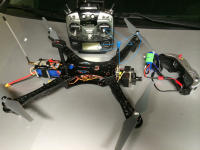"Higher end" products can make a difference. Sometimes they make very little difference. You have to understand that this hobby is an odd one. If you're not already into electronics and RF then typically, you'll spend more money in the beginning buying the "ready made" stuff until you learn more, where you'll spend less and maybe even build some of your own parts.
Multicopters just have such a steep learning curve if you're not already into RC in some way. I have flown RC for many years - over the last 6 years, I got into helicopters and then multi's. Even though I knew how to configure Futaba and Spektrum radios really well - understood servos and gyros, built my own helicopters, etc. getting into multirotors was just such a major change.
First, you start with DJI. If you're not an electronic engineer, then you need to buy a DJI 450 or clone and buy a Naza v2 with GPS and get the small OSD unit. Get a decent camera - many of us went the DJI route for camera gimbals as well for Aerial Photography. This is a solid way to learn.
I still like the Naza v2 for AP stuff, but for just flying fun, I'm into mini's and racers. That's a whole other world, where you find out you could have gotten a flight controller for $50 bucks - or even with GPS for under $100. Seems like the more you learn, the more you learn how and where to save money.
Unfortunately, not too many people can define "your" path for you. Buy a few things, make some mistakes or determine which things you want to upgrade. Figure out where you want to spend your money. Play around a bit - crash a few times, etc.
If you really have a lot of obstacles in your way, you're going to need 1.3Ghz - probably ought to just buy a pepperbox antenna. 5.8Ghz is ok, if you've got a great line of sight to all the areas where you'll be flying. If you don't have that, then 1.3 is the way.
Just to start, I really like the hobbywireless.com modified 1000/500mw 1.3Ghz transmitters. Lawmate isn't always good quality, but hobbywireless seems to check the quality before they modify the transmitters, so you know you're getting a decent unit when it comes.
http://hobbywireless.com/12-13-ghz-...1213-ghz-plug-play-transmitter-usa-p-155.html
I'll swear by those forever. However, that and the antenna are probably the only thing I'd get there. Get the 1.3Ghz receivers from RMRC with the saw filters in them. I like those a lot more.
http://www.readymaderc.com/store/index.php?main_page=product_info&cPath=11_34_44&products_id=1015
http://www.readymaderc.com/store/in...duct_info&cPath=11_45_52_100&products_id=1288
You "might" be able to get away with a simple omni, like:
http://www.readymaderc.com/store/in...duct_info&cPath=11_45_52_100&products_id=3609
However, if you're flying behind things like a hill and thick trees, there's no substitute for the pepperbox.
I also like RMRC's FPV cameras. You can get inexpensive ones for around $29 bucks. They're 600-700TVL and ok.
I have this camera and several cheap ones:
http://www.readymaderc.com/store/index.php?main_page=product_info&cPath=11_62_12&products_id=579
I think it's excellent because of it's speed and dynamic range.
You're going to need to look into LC Filters and learn about voltage regulators, etc. Read up on this, it'll help the quality of your video big time.
I also have Fatshark Dominator v2's and Boscam GS920's. I like the way the Boscam wrap around my face better than the Dominators. However, Dominators have a recorder in them and allow RF modules to be changed out, which for me is quite nice. Still, the Boscam unit is still really great. If you want to be tethered to your RF receiver - which is fine, then you don't need anything beyond
http://www.readymaderc.com/store/index.php?main_page=product_info&cPath=11_22_227&products_id=1193
However, you'll always need to be tethered with these. With Dominators or Boscam or Skyzone, you can use them tethered, or setup a repeater/relay ground station like I have. Your choice.
As for transmitters for your RC, I only use Futaba. I have two 14SG's and also several Spektrum radios, but I prefer the Futaba. It's cheap to repair, always works, I know my way around configuring it and it's very configurable. Plus, the new firmware for the 14SG speaks just like many of the expensive radios do, so... I don't know anything about Tarannis, but I hear they're great too.
Currently, I do a lot with DragonLink. The new receiver for DragonLink is small, completely configurable beyond anything I've encountered before, and just works wonderfully well - very lightweight too. You might not need an LRS, but if you do, look into them.
Research, research, research... read the forums and then read some more.
Good luck!

